All about opal stone
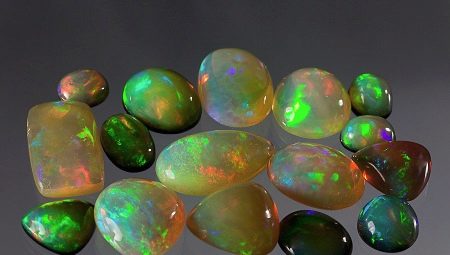
Opal is an incredibly beautiful natural gem, which since ancient times has been considered the stone of royal dynasties and the rich. For many peoples, this stone is proof of divine power on Earth, for others, it is a dangerous magical attribute that can harm any uninitiated. In this article, you will get acquainted with the features of opal, its varieties, the main deposits, as well as the rules for caring for this amazing mineral.
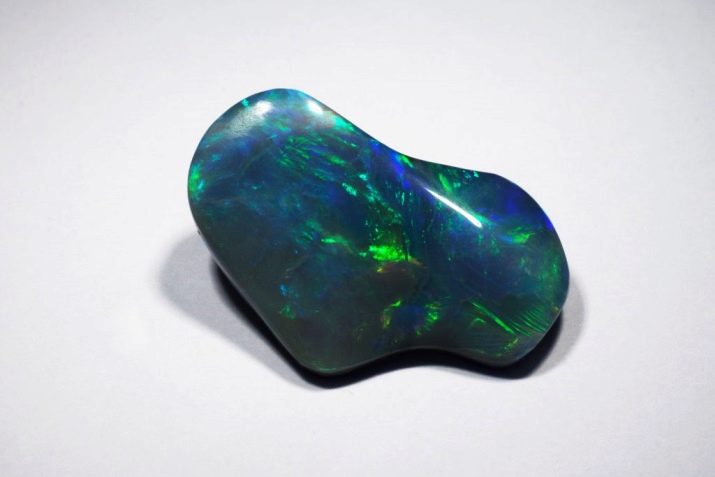
What it is?
Scientifically speaking, this stone is a mineral from the silica family. If we consider the chemical composition of the stone, then this is an ordinary silicon oxide of a globular structure. In narrow circles, opal is called fused silica because of its unusual physical characteristics.
In addition to the elements of the basic formula, the composition of opal can include aluminum, as well as oxides of iron, magnesium and calcium. It is their content in opal that affects its color, the quality of overflows and opalescence (an optical phenomenon in which specific overflows and facets are formed inside the mineral when the angle of illumination changes).

External physical characteristics of opal.
- Colour. At the moment, more than 30 shades are known, which are found in both precious and semiprecious varieties of this stone. Among the most common are colorless, white, straw, brown, red, green and light green, chestnut, black, azure. It should be noted that rare and expensive opals are distinguished by the dominance of a particular color.
- Transparency. There are transparent, translucent and opaque opals (dark shades, for example).Translucent and translucent minerals tend to be much more expensive - they create unique color highlights that make it easier to identify authenticity.
- Shine. For opal, depending on the type, color and additional elements in its composition, three types of gloss are characteristic: glassy, waxy, dull (weak or cloudy gloss).
- Density. In opals, regardless of the variety, it always remains approximately the same: from 1.8 to 2.4 g per cubic centimeter.
- Hardness. Experienced jewelers rate the hardness of natural stones at 5-6.5 points on the Mohs scale.
- Strength. Despite the solid structure, the stones are extremely unstable and fragile even with a slight pressure.
- Break. Crustaceous type.

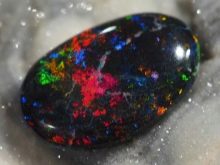

Due to its globular structure, opal needs constant water replenishment. Natural opal stone contains from 6 to 10% water, in some modern rocks the proportion of water is even higher and can reach up to 30%.
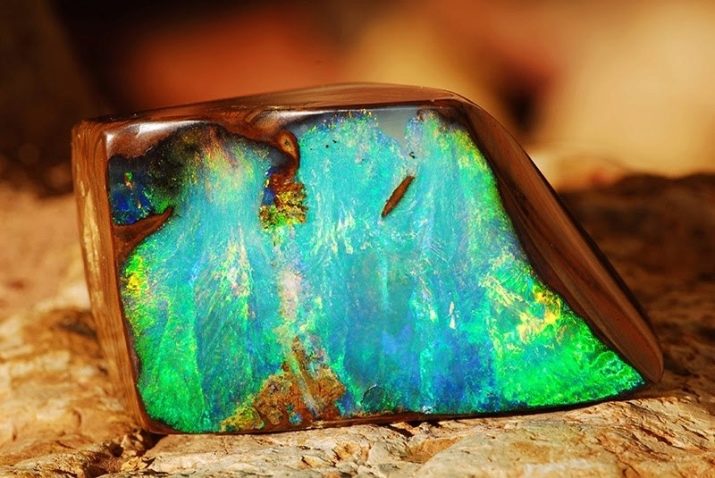
Water absorption and loss is normal for opal. If the stone is left without water for a long time, cracks and chips begin to appear inside it. If you expose the stone to a strong thermal effect, then already upon reaching the mark of 100 degrees, this rare mineral turns into ordinary chalcedony.
It is believed that this stone got its name from the Sanskrit (ancient Indian) word "fell", as well as from the Latin "opalus".
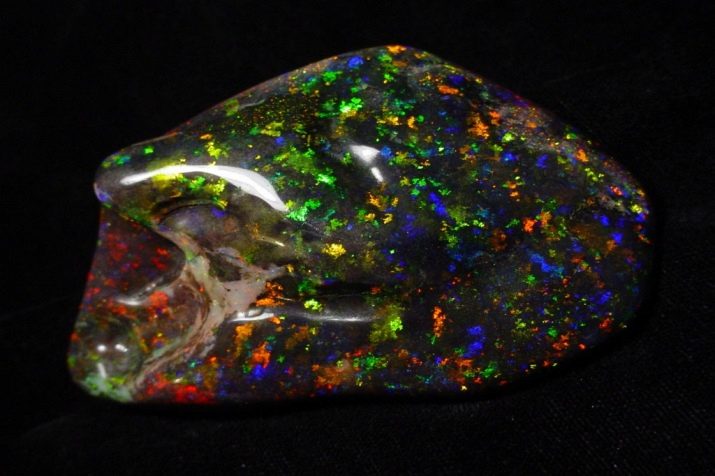
Features of origin
Opal is of sedimentary hypergenic origin; it can be found both in the form of separate plates in the rocks of diatomite, tripoli and flask, and in the form of specific veins in these rocks. In the natural environment, opals are present in the form of sinter nodules or nodules that cover other minerals. Often, it is thanks to opals that fossils of plant and animal origin are formed.
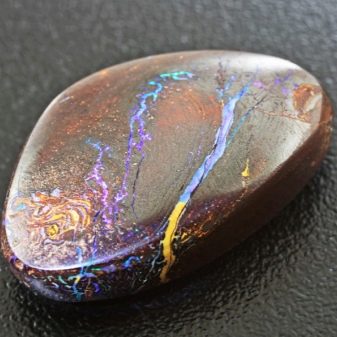
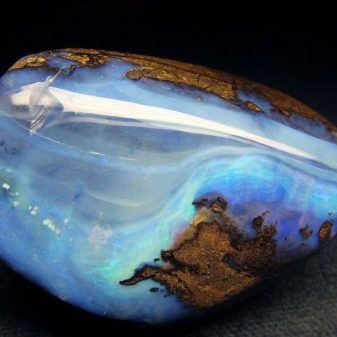
The formation of these minerals occurs as follows - in some arid region, it rains heavily, after which moisture enters the earth rocks and fills the ground cracks. Over time, moisture evaporates and layers, forming ordinary silica.
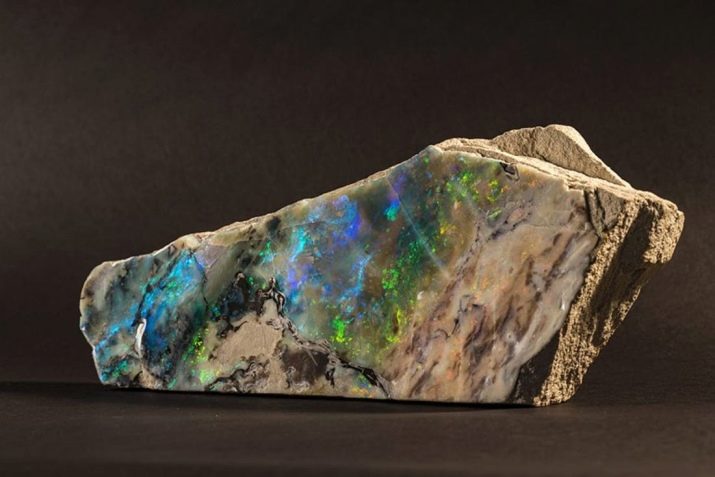
In addition to the natural explanation of the origin of this stone, there are dozens of myths and legends in the world associated with its appearance on Earth.
- The Australian indigenous people believed that many years ago the Creator came to Earth to explain to people the meaning of the rainbow, sky and clouds. When he stepped on Earth in his divine form, the pebbles and stones under his feet became shiny and colorful.
- According to Japanese legends, it is believed that at the moment of the creation of all things, the Creator blessed the Earth and laid a particle of the Sun in the rocks so that the soil would always remain warm and rich. Modern opals were formed from this particle.
- The ancient Greeks believed that opals were the tears of Zeus himself, which he dropped after defeating the titans. Only when they touched the ground did his tears turn to stone and scattered across the globe.
- Indian legends tell of the great and beautiful goddess of the rainbow. Her beauty and divine light drove all men crazy, who very soon decided to encroach on her innocence through brute force. Falling into a trap, the goddess threw herself off a cliff and scattered all over the world in thousands of sunny and rainbow gems.
- Scandinavian myths tell of a blacksmith who created opals from the eyes of a small child to capture their natural beauty and charm forever. Since then, the Scandinavians have believed that if you peer into the depths of blue and blue stones for a long time, you can certainly see the face of a baby.
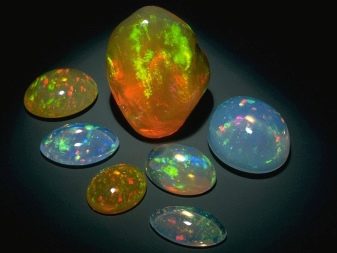
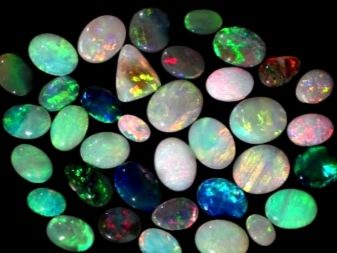
In addition to legends about the mystical origin of the stone, a large number of other beliefs are associated with it. For example, in the Middle Ages, thieves loved to wear opals - they believed that the stone could make them invisible in moments of danger, and its lulling depth acts on victims like real hypnosis.
In one of the novels of the world famous Walter Scott, opal is described as an extremely dangerous and devilish stone., which fades from holy water and is used by sorcerers and witches for evil conspiracies and curses. Since the novel gained widespread public acceptance, many have given up wearing this mineral.This continued until the 19th century - it was then that Queen Victoria began to actively use opals in the creation of jewelry and jewelry, and also often gave jewelry with this stone to her friends and members of the royal family.
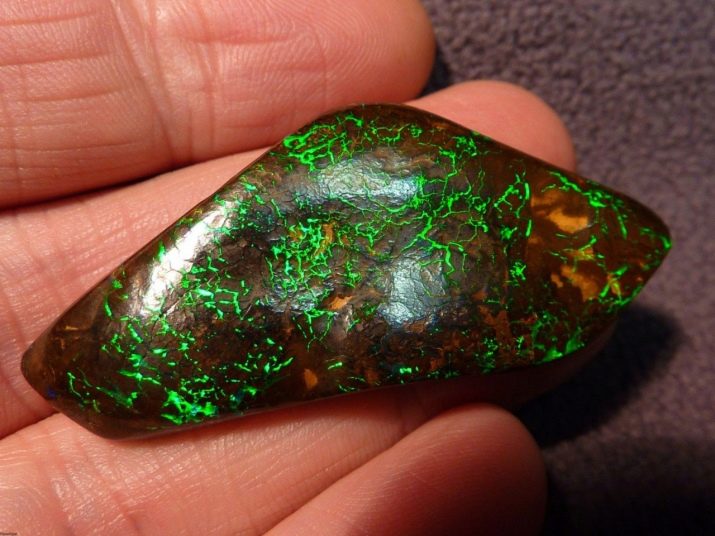
Where is it mined?
For the formation of natural beautiful opal, certain conditions are necessary: special pressure, temperature, humidity level, the presence of other factors. In addition, the formation of some rocks of this stone takes not even tens, but hundreds of thousands of years, which makes them even more rare and attractive.
It is noteworthy that most of all the stones that you can find in jewelry stores are mined in Australian territory. Opals were discovered there in the 19th century, and quite by accident. A local hunter tracked the movements and stops of the kangaroo and found one unusual iridescent stone at one of the camps.

Almost immediately, this previously ordinary area with sparse vegetation and an arid climate became a site for excavation and research. Tons of this mineral have been found beneath the soil, filling cracks in rocks, sandstone and basalt.
In addition to Australia, opal deposits have been discovered in Mexico and Brazil. - it is from there that minerals of honey, red and red shades are often brought. A small proportion of transparent stones were once mined in Sudan, while minerals of deep brown, dark and brown shades were found in Ethiopia.
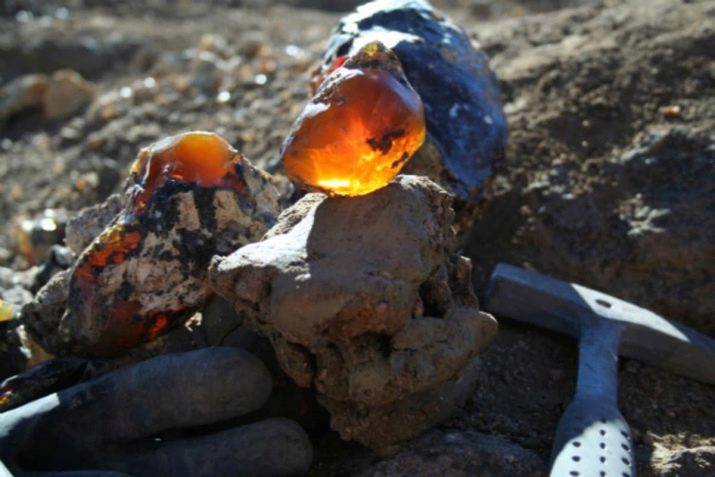
The oldest known opal deposit is considered to be the region of Cervence in the Czech Republic. This territory belonged to Hungary for some time, and therefore the opals mined in this area are usually called Hungarian. There is an assumption that the very first opals, which were found in the ceremonial jewelry of the ancient Roman rulers, were mined in this area.
Russia, despite its dominant position in the extraction of many natural elements and metals, is not particularly rich in opals. Some meager deposits are rarely found in Kamchatka or Siberia.
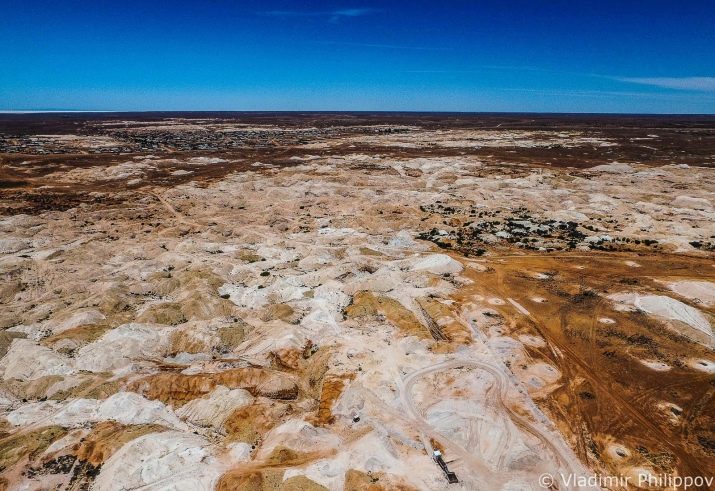
Properties
Opal is known all over the world not only as an exotic and expensive jewelry, but also as a mineral with amazing medicinal and magical properties.
Magical
Opal has long been considered a stone with incredible energy, which can push weak-willed and insecure people to commit terrible or forbidden acts. This stone is uniquely useful in the hands of talented and gifted people - only then it reveals all its magical potential and is able to help a person achieve incredible creative heights.
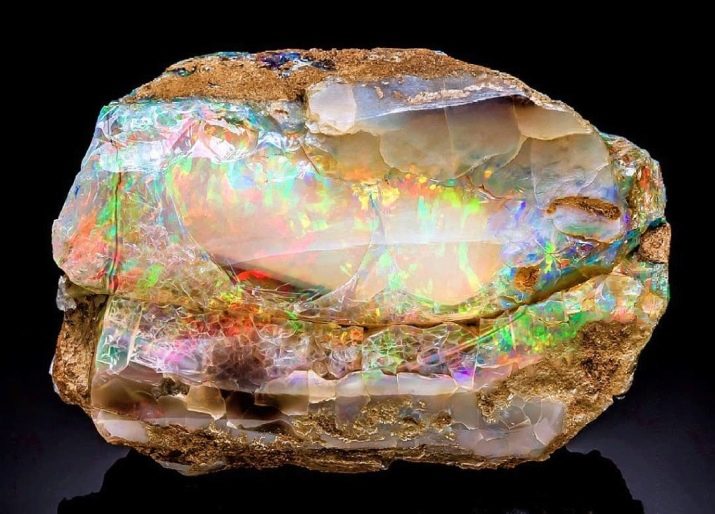
Many people know opal under a different name - "the stone of deceiving hopes." This means that it is able to endow its owner with incredible ambitions, ideas and desires. However, if the owner is experiencing difficulties in his creative path or delays in fulfilling his plans, the opal engenders doubt and self-doubt in him. Extremely strong people with a stable character can cope with the powerful energy of this stone.
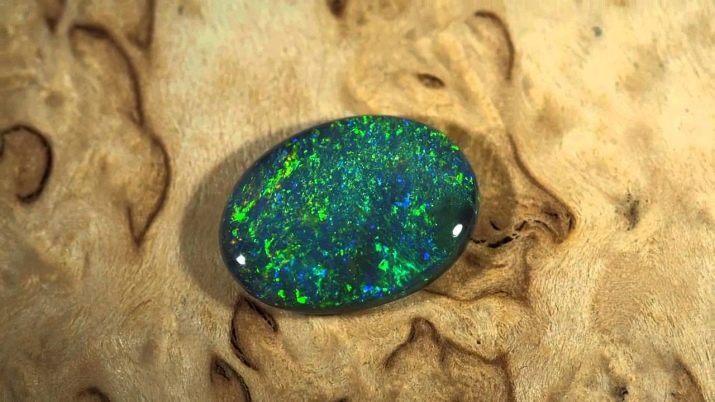
Despite its ambiguous nature and abilities, this mineral is an extremely benevolent stone that you just need to know how to handle. For people with clear life goals and attitudes, he will become a real bodyguard. He will help track the hostile plans of enemies, rivals and traitors, thereby endowing his master with a prophetic gift.

Many esotericists believe that the true magical power of the stone is revealed only in good hands, whose actions are directed precisely in the creative direction. In evil, arrogant or unclean hands, the energy field of the stone is transformed, and he himself becomes the initiator of quarrels, disputes and confrontations.

Now it is worth describing the general magical properties of opal, which are attributed to it by all astrologers and esotericists.
- It directs thoughts in a creative direction, helps to focus attention on a specific goal or idea.
- In good hands, he is able to drive away negative emotions, relieves of the fear of mistakes or fear of doing something.
- Helps in building relationships between colleagues, relatives and partners.
- The strong magical aura of opal makes it an ideal amulet against dark forces and magic from other people.
- Motivates to bring the work started to the end, even if it requires significant effort.
- Endows the wearer with a prophetic gift. In other words, it endows with sharp analytical thinking, which helps to calculate the outcome of all actions several moves ahead.
- It is the bonding stone of the family hearth, it is able to stop quarrels at the very beginning.
- For creative people, opal is simply an irreplaceable assistant as an inexhaustible source of inspiration.
- In an extraordinary and emergency situation, opal will help not to lose vigilance and focus on the highest priority goal, thereby helping to emerge victorious even from the most difficult situations.
- Opal can also help in the field of love; it is simply an irreplaceable stone for those who are in a long search for a partner. In addition, he is able to return a person and establish an atmosphere in a relationship with the intensity of passions.

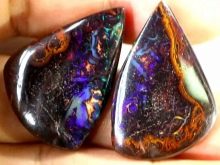

Now it is worth considering the magical abilities of the stone, depending on its color.
- Opal is black or dark in color. It is considered a stone of passion - it is simultaneously capable of sharpening mental abilities, but it can also push you to fulfill secret sexual desires (which can ultimately lead to treason).
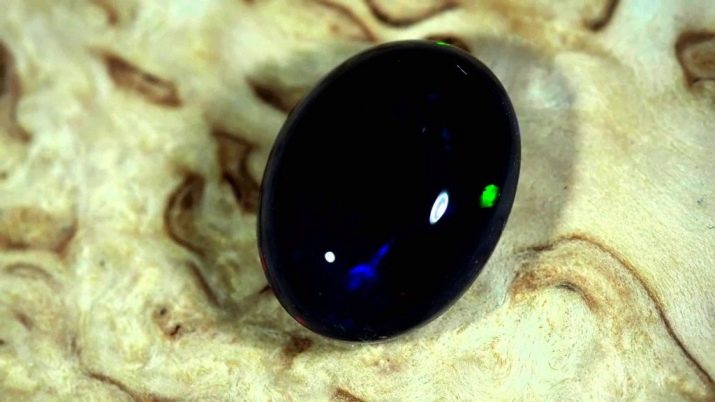
- Opals are white or transparent. The stone of calm and peaceful people who know what they need for life. Usually it is bought for respectable women and men who have already achieved everything in life. This opal endows its owner with calmness, patience and compassion. Great for doctors, educators and leaders.

- The stones are blue, azure or cobalt. It is believed that these stones are real magnets for good luck and luck. It is the owners of blue opals that often become winners in lotteries or random contests. In addition, the azure mineral helps in achieving the set goal, focusing the wearer's attention on the priority tasks.
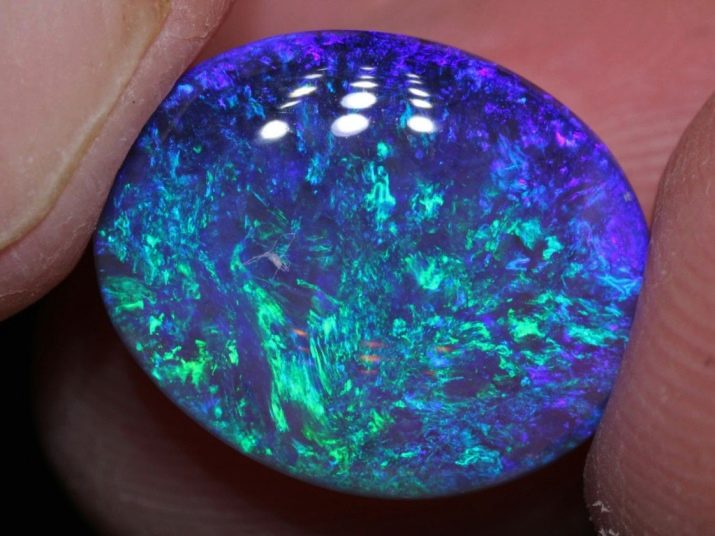
- Opal minerals of fire, red and red colors. Such opals are real motivators for the accomplishment of courageous, decisive and brave deeds for men. This mineral gives women sensuality, purity and wisdom. For partners in marriage, such a stone is simply irreplaceable. It is believed that it is opals of fire shades that are most often used for carrying out esoteric rituals (removing damage, directing cash flows, removing ancestral curses).
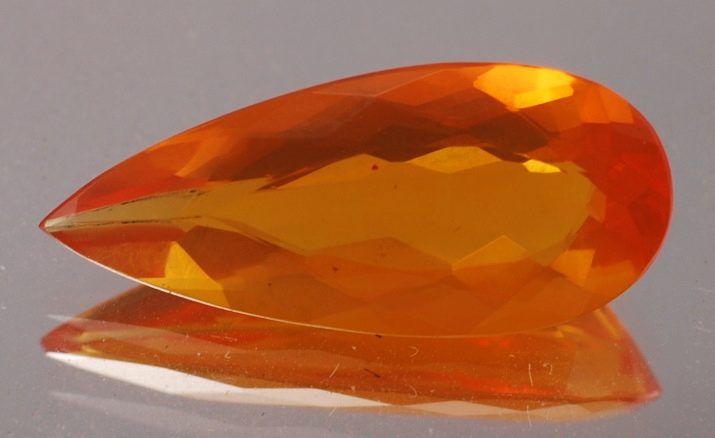
Regardless of what goals you want to achieve using opal, its magical properties should not be underestimated. Some mediums do not recommend wearing it all the time - your own aura should be resting from its energy. Including, it is not recommended to wear opal with stones as powerful as obsidian, pearls and topaz. Only in the hands of a confident person, these stones will not contrast with each other and will be as useful as possible.

Therapeutic
In addition to its extraordinary abilities, the mineral has a number of properties that are actively used in such a field of alternative medicine as lithotherapy.
Experts in this field claim that this mineral has the following healing properties:
- tidies up the work of the nervous system, increases the stress threshold;
- tones and balances, gives the owner a good mood;
- improves the work of the muscular system, helps to eliminate cramps;
- normalizes the work of the cardiovascular system, restores the heart rate;
- able to eliminate redness of the eyes, can generally improve vision;
- tones up the digestive tract, is able to favorably influence the functioning of the liver and kidneys;
- cleanses the body of useless and harmful elements;
- prevents the occurrence of depressive disorders;
- increases the level of potency;
- helps to fall asleep faster, makes dreams pleasant and calm.

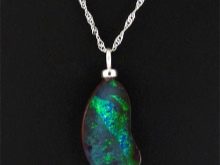

Also, this stone is recommended to be worn by pregnant women - it will form the correct character of the child already at the stage of birth and will facilitate the birth itself.

Views
Today in the world there are more than 30 varieties of opal. They were selected based on the characteristics of color, strength, hardness, gloss, transparency, weight, size and density.

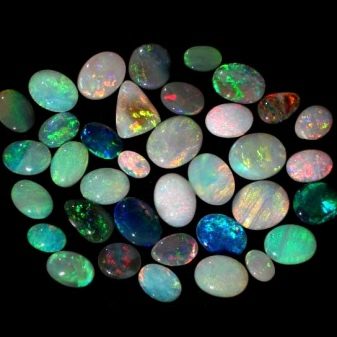
The first classification of these minerals divides them into semi-precious and precious minerals.
- Precious, or noble, opals are a priori very beautiful stones with transparency and clearly defined opalescence, which is expressed through numerous smooth color reflections inside the stone. This type of stone is extremely rare, very expensive and is used exclusively for the manufacture of jewelry and jewelry.
- Semi-precious or ordinary opals have a partially transparent structure, rarely have brightly marked iridescent tints, and have a dull, discontinuous color. They are much cheaper and are found literally in every jewelry store at the heart of inexpensive accessories.
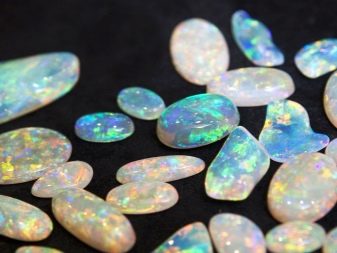

Now it is worth considering the varieties of opals, based on the classification presented above.
Types of noble opals.
- Black. They are the most expensive of all breeds. They come in deep purple, deep black or purple. The stones are weakly transparent in their structure, however, they have a pronounced orange or fire opalescence.
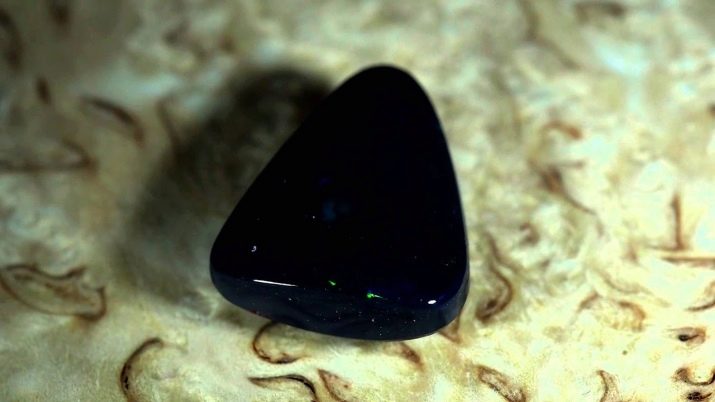
- Fiery or red. These minerals are presented in the form of transparent or translucent stones of rich red or peach colors. Some rocks of these stones have a pronounced reddish opalescence (for example, mined in Mexico).
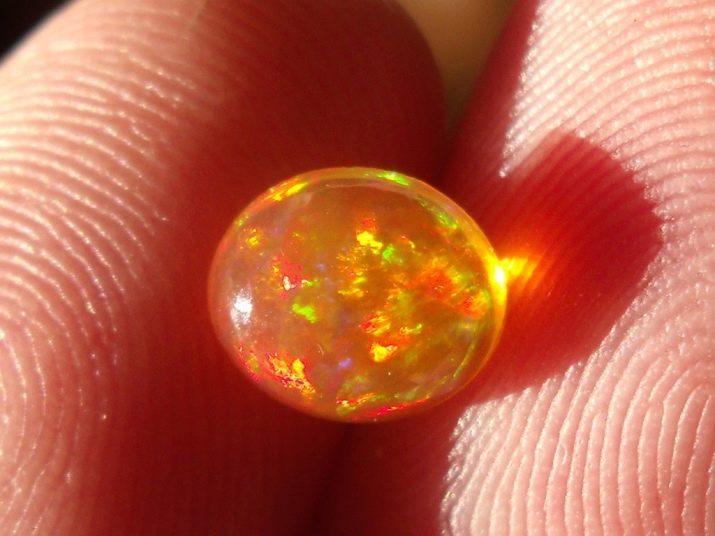
- Harlequins. Mineral got its name from the characters in Italian comedies, whose attire consisted of numerous multi-colored pieces of fabric. These stones are distinguished by an amazing variegated pattern in the form of numerous spots or shapeless figures of red, blue, yellow, green and purple colors. If you put such a stone in your palm and bring it to the sun, a real rainbow will play on your hands.
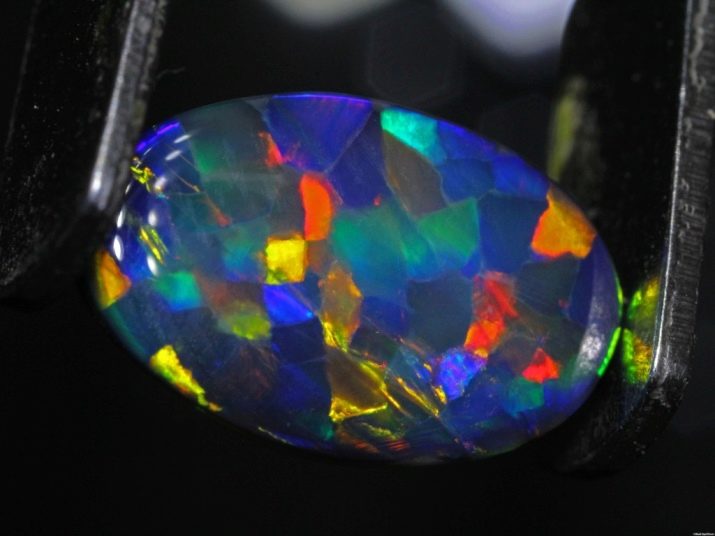
- Royal opal. It is an extremely rare type of opal, which is used only for the production of royal jewelry. Possesses a unique saturated lazurite color, as well as a translucent structure.
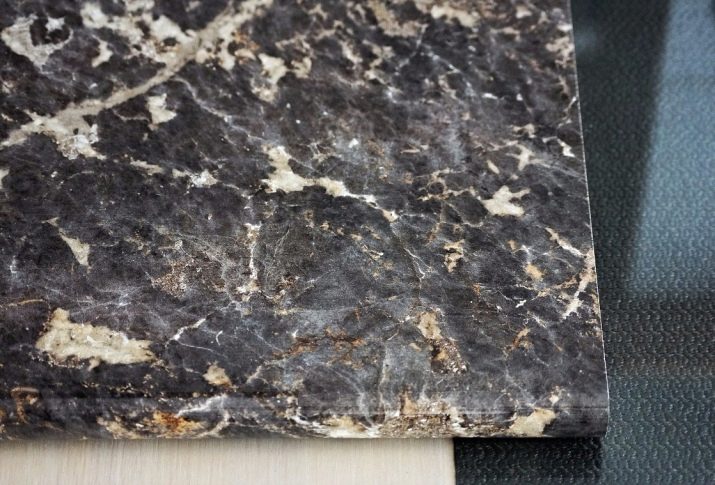
- Jirazol or heavenly, blue opal. Incredibly beautiful, almost colorless, transparent opals with a unique blue opalescence. It is in these minerals that so-called "algae" from other rocks are often found. Jirazol deposits have been discovered in Mexico, USA, Czech Republic, Russia and Australia.
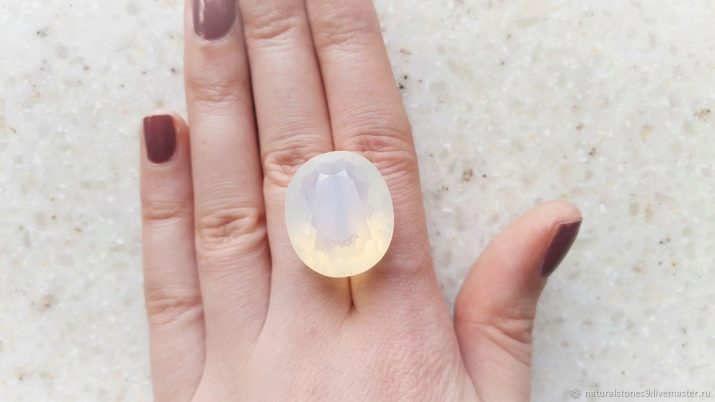
- Lejos. Incredibly beautiful minerals with vibrant emerald and marine pigmentation. It is also considered one of the most expensive varieties.
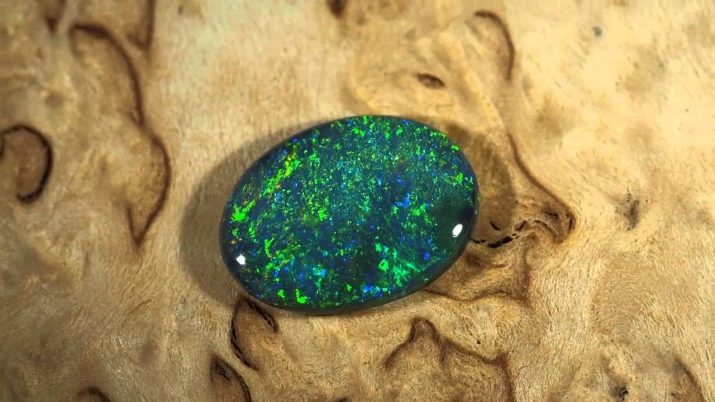
- "Cat's Eye". Presented in the form of minerals of yellow, honey and wheat shades, they have a weak transparency. Often in the very center of such a processed mineral there is a characteristic strip that has some similarity to cat's eyes. It is considered the same expensive and rare variety of opals as dark stones.

- Tsarsky. A rare type of mineral with extremely bright contrasting shades throughout the texture of the stone.

- Ethiopian. A precious variety of opals characterized by an exceptional ultramarine translucent color with multi-colored opalescence. As the name of the variety suggests, she got it from her mine.The texture of Ethiopian opal is similar to that of jirazol, but the latter has a more pronounced opalescence.
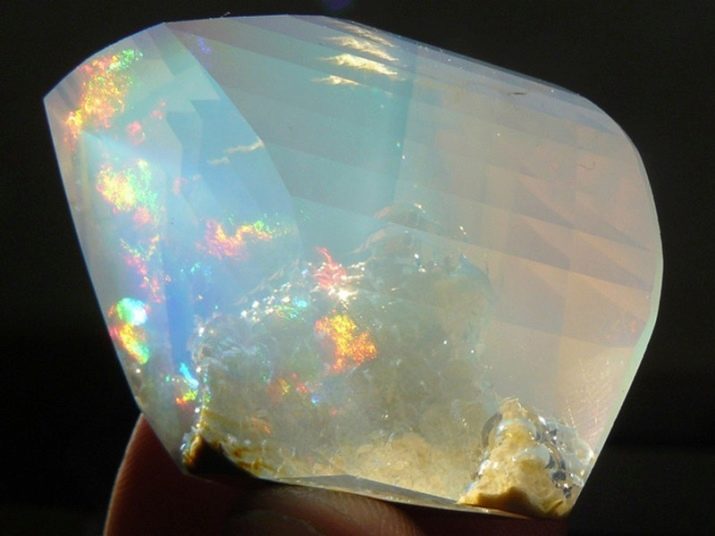
- Pink or Andean opal. It is mined in significant quantities in South America, where it is considered a mystical and sorcerous stone. It differs from other representatives of its breed in a delicate peach or pink shade. Its texture is very similar to rose quartz, but with a more opaque texture.
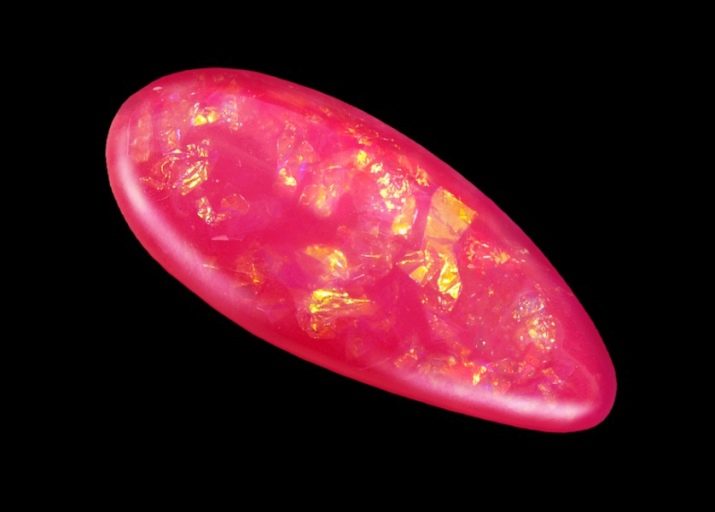
In addition to precious opals, there are also semi-precious ones. These include the following.
- Hyalite. Almost colorless opal with a dull white color and a complete absence of opalescence. Almost 30% water.

- Chrysopala. A common type of semi-precious opal that can often be found in inexpensive jewelry. The texture is opaque, the color is solid - usually light green or dark green.
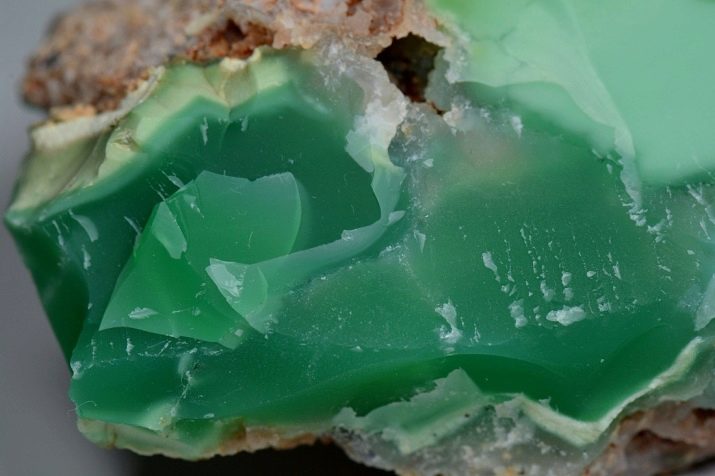
- Moss opal. A well-known variety of semiprecious opals with a black and white color and a translucent texture. It differs from other varieties in a specific dark pattern on a white background, which seems to depict dense grass thickets or cracks.
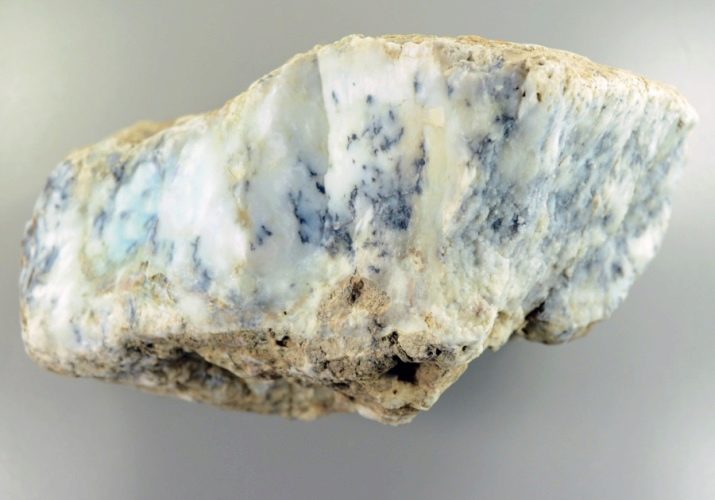
- Hydrofan. A type of opal that acquires surprisingly bright opalescence and transparency when immersed in clean water. It is believed that hydrophane is the final stage in the development of any precious opal.
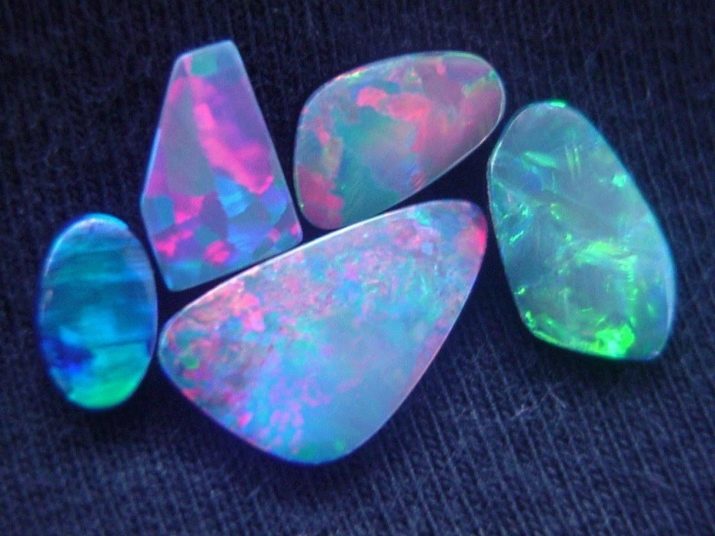
- Peruvian. A variety of pale blue or sky-colored opals that are still actively mined in Peru.
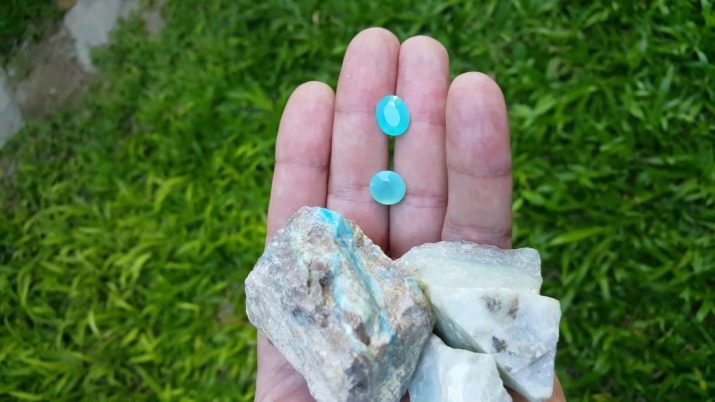
Some jewelers claim the existence of a separate type of opal, the so-called Australian. However, when this term is mentioned in any context, all varieties of opals found in the deposits of Australia are meant.
Where is it used?
The exceptional physical properties of opal made it practically unsuitable for widespread use in large industries. It does not have high strength, is not able to withstand high temperature and pressure.
However, opal managed to confidently gain a foothold in the jewelry field. Today, individual jewelry made from the most beautiful natural opal can cost up to several tens of thousands of dollars. At one time, this stone was valued no less than emeralds, diamonds and pearls.
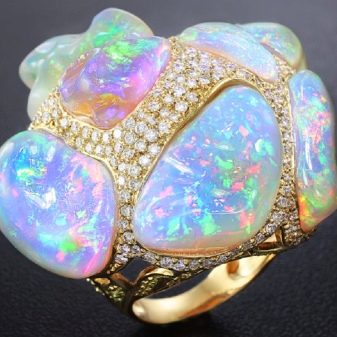

Women prefer to buy brooches, hairpins, bracelets, rings, tiaras and pendants with inlaid opal stones. Men prefer rings, pens, cufflinks and buttons with this mineral.
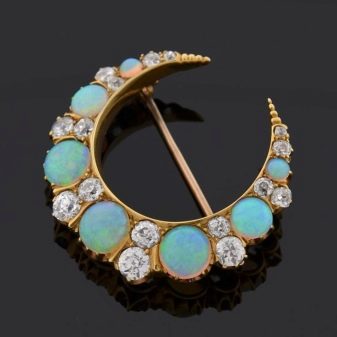
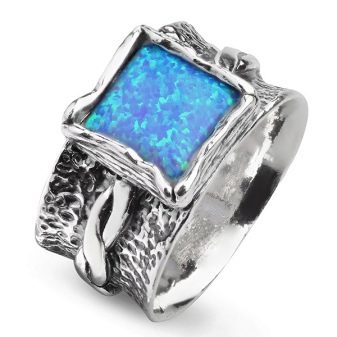
In massive jewelry, opal looks great with agate, aquamarine, ruby and jasper. In the CIS countries, they prefer to make bracelets and necklaces with opals, amber and carnelian.

Who is it suitable for?
There is a misconception that opals are only suitable for people with some strictly defined mentality or character. This is fundamentally wrong - opals have such a strong and multifaceted energy that they are able to serve faithfully to any owner.

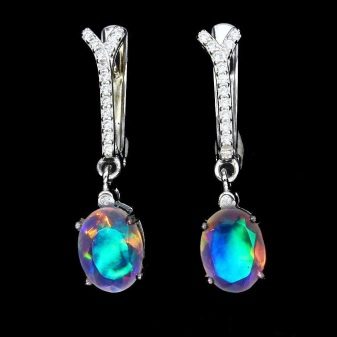
It should be said right away that the difference in the perception of some stones directly depends on their color. The rarest and most expensive representatives of opals are black, truly suitable only for Cancers, Scorpions and Aquarius.
- Fire signs of the zodiac. For Sagittarius, Aries and Lions, opals of white, variegated and light blue shades are best suited. They will help hide both internal and external flaws, suppress negative emotions, and can also develop qualities such as determination, perseverance and determination in a strong person. Aries are most suitable for white or variegated stones - opals of deep, saturated and dark colors are not suitable for this zodiac sign. For Sagittarius, on the contrary, opals of azure, cobalt and blue shades are suitable - they will endow their owners with analytical skills and inspire new ideas.
- Air signs of the zodiac. Gemini, Aquarius and Libra can coordinate with both fiery and white opals.Light stones will fill these signs with calmness, confidence and serenity, and fiery ones, on the contrary, will add playful, risky and mischievous notes to the temperament of these signs. Deep blue opals are great for Aquarius, while Gemini often prefers variegated, multifaceted colors that reflect their volatile and fickle nature.
- Zodiac water signs. Pisces and Scorpios need a constant source of strength and inspiration, as well as energy to complete their daily activities. Such energy is endowed with opals of red, red and blue colors. In addition, such stones will endow Pisces with an even sharper intuition, and Scorpios will help to focus all their energies on a certain priority goal. Cancers can wear opals in white, red and dark colors. For this sign of the zodiac, this stone will help to improve the financial situation, soothe inner anxiety, and help establish relationships with the opposite sex.
- Earth signs of the zodiac. For measured Taurus, Virgo and Capricorns, opal can only be useful as a talisman or some kind of barrier from external stimuli. This stone softens the natural stamina and decisiveness of these signs, makes them kinder, more compliant, and reduces innate cynicism. Prone to planning and constant control, earth signs will find a real support in the face of opal, which will relieve them of the worries and fears that something might go wrong.
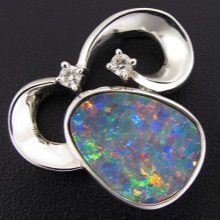
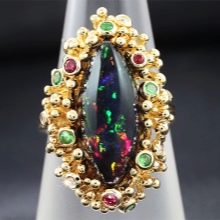
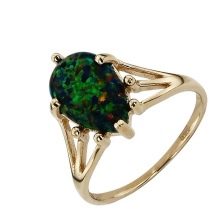
It should be understood that a stone with such a strong energy cannot always behave obediently. There are often cases when opals literally eluded the owners (jewelry with opals was unfastened, fell out of pockets, or simply fell off the shelves in the house). This happens when the stone feels a lack of attention and respect for itself. It is in this case that they will not bring any benefit or harm to the owners. To change the situation for the better, mystics advise to talk to the stone regularly, carry it with you and clean it weekly.
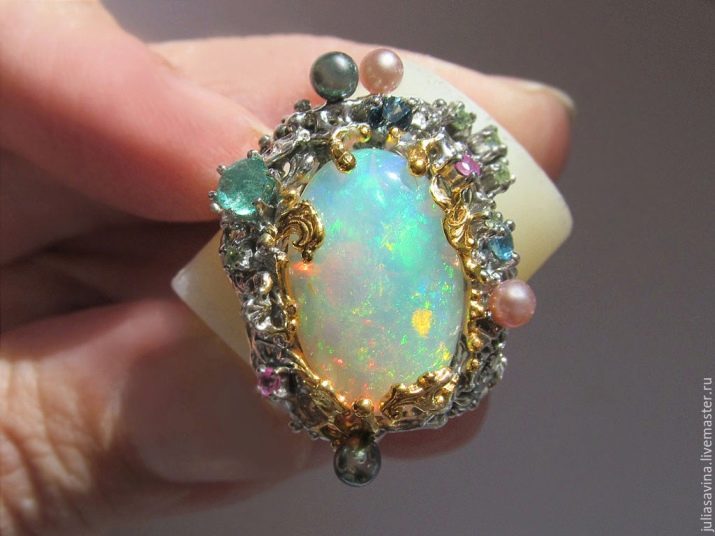
How to distinguish from a fake?
The sun shimmers and reflections of opals have been known to the whole world for a very long time. Precious opals began to be widely forged as early as the beginning of our era. Initially, imitations of these minerals were made from glass, which was first heated and then abruptly placed in cold water. As a result of this procedure, glass crafts acquired cracks, became cloudy and darkened. Pliny is considered a well-known connoisseur of opals of that time, who advised checking opal for authenticity in the sun. Based on his beliefs, minerals of natural origin will certainly cast glare.

Today, using this method, it is impossible to determine the authenticity of the opal. Thanks to modern technologies, craftsmen have learned how to create beautiful imitations using doublets and triplets (a kind of films that are glued to the future stone material). The basis for such stones was quartz, glass and plastic.
There are known cases of resin staining of semi-precious opals to achieve unusual and bright colors. Today products of this type have acquired a new name - imitation of a mineral. According to the law, such activities cannot be prohibited in any way if the seller indicates in the description of the goods that this is an imitation, and not an original.
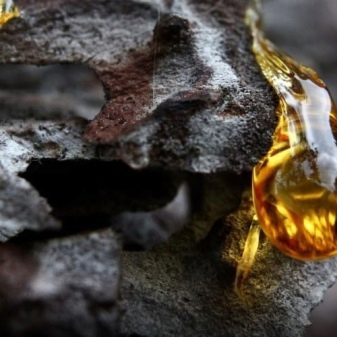
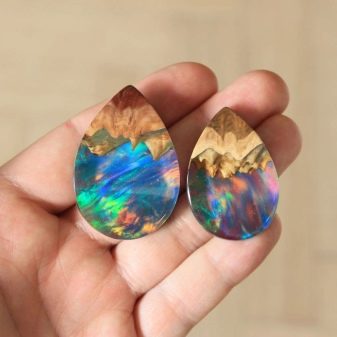
The easiest way to find out the authenticity of a mineral is by asking the seller about it. A seasoned trader will not risk a career or a place in the market to lie to you about the authenticity of a mineral. Do not think that the more expensive the stone, the more likely it is natural. There are cases when fakes of opal cost much more than the originals only due to their supposedly "exceptional color", which will peel off at the first fall.
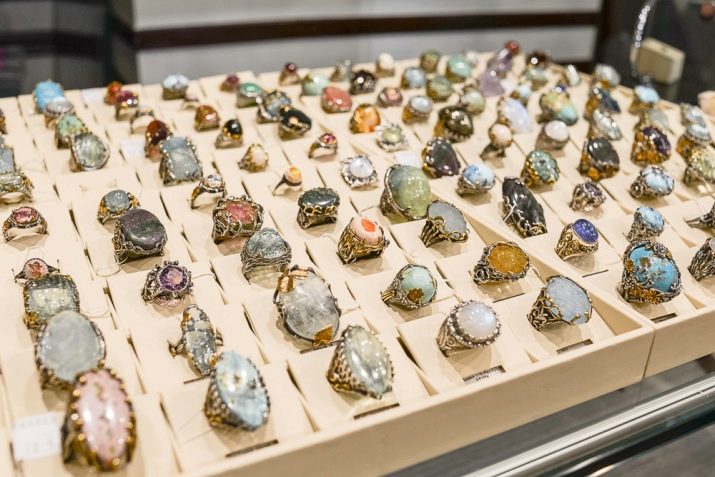
It will be difficult for an inexperienced buyer to understand whether it is a fake or an original. Further, you can familiarize yourself with the inspection rules that will help you choose not only a beautiful, but also an authentic mineral.
- The weight.Glass, plastic and wood are usually much lighter than real opal.
- Opalescence. The so-called optical effect, which is characteristic of all precious stones. The overflow of this stone is multi-colored, extremely smooth and soft. Most glass imitations have one single color in the overflows, and the transitions themselves inside the stone are unnaturally sharp.
- To determine the authenticity of a clear opal, simply place it in direct sunlight. If the stone is real, a whole rainbow of various shades will play on your hands. If artificial, you will notice only a few fuzzy shades.
- If the stone is a glass imitation, then when you examine the mineral under a magnifying glass, you will clearly notice small balloons or bubbles.
- Another way to identify imitation opal is to simply lean your purchase against your tongue. It is believed that any fake (especially glass) will definitely stick to it.
- Natural opal placed in dyed, dirty or muddy water is bound to change its color. If the stone is not real, it will remain the same color as when purchased.
- The interior designs and overflows of natural opals are always original. They never repeat themselves.
- Sound. Any solid mineral produces characteristic metallic sounds when hitting hard objects. This will help you identify a plastic or wood fake.
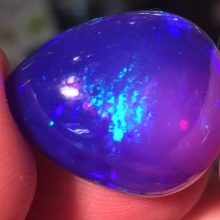
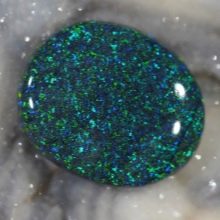
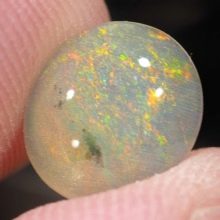
Sometimes imitation opals can be really prettier, cheaper and stronger than natural stones. However, it should be understood that a fake will not have any magical and medicinal properties. Imitation opals are great materials for creating inexpensive jewelry and home furnishings.
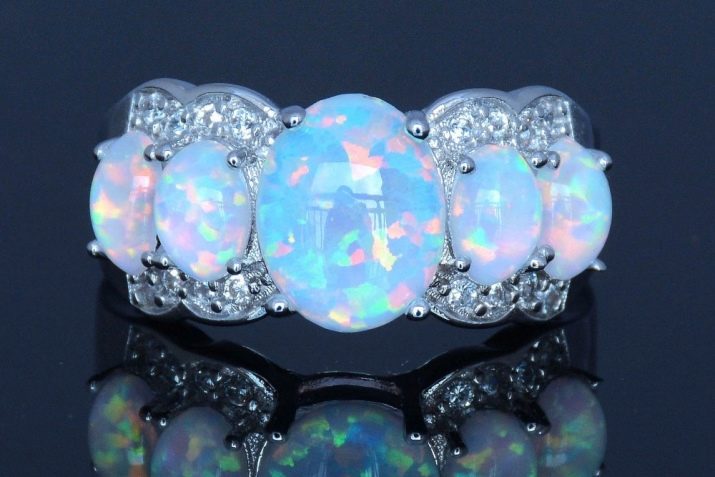
How to care?
Unlike many semiprecious and precious minerals, opal needs special conditions of detention. In unsuitable conditions, these stones can crack, grow cloudy and crumble.
It is worth considering the rules for storing this mineral at home.
- Constant moisture. To preserve the unique solar play and color patterns inside the opal, you need to constantly wear it on your hands (to absorb moisture from the skin), and also store it in a cool room with a high level of humidity. In the absence of moisture, cracks begin to form in the opals, the stones themselves lose their luster and become cloudy. If you cannot provide the stone with a constant flow of moisture, you can store it inside a damp cloth or cloth, or simply rinse it occasionally with water.
- No alkalis. If you are starting a house cleaning or just a session of preventive maintenance of the interior - immediately take off your opal jewelry. This stone does not tolerate the influence of any detergents and preparations.
- Temperature and direct sunlight. This stone feels best at room temperature. You shouldn't take it with you to the beach, to the sauna or to the hot bath - there is a high probability that it will simply crack or completely lose color.
- Cosmetics. Try not to put cosmetics on the stone - varnishes, paints, conditioners, shampoos, tonal creams will ruin it.
- Be careful. Despite their external strength, opals are extremely unstable against collapse and strong pressure. Just be careful with your opal jewelry and don't let it fall.
- Cleaning. You should not use even the most gentle opal care products. If the stone becomes cloudy and dirty, just rinse it under running water and wipe it with a silk cloth. Jewelry cleaning should be done separately from the opal itself. Refuse steam or ultrasonic cleaning, they will only harm the integrity of the mineral.
- Recovery. Opals, which are often used as jewelry, are characterized by cracks and scratches. To get rid of them, it is worth taking the mineral for restoration to a jeweler or polisher.
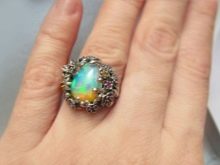
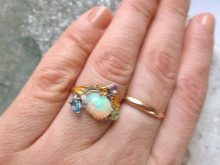

It is in your best interest to keep the opal looking neat and tidy.It is believed that a dirty, cracked and clouded stone can really harm its owner.
All about the opal stone, see the video below.








